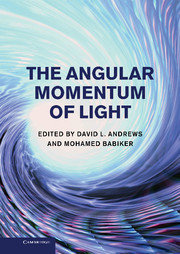Book contents
- Frontmatter
- Contents
- List of contributors
- Preface
- 1 Light beams carrying orbital angular momentum
- 2 Vortex transformations and vortex dynamics in optical fields
- 3 Vector beams in free space
- 4 Optical beams with orbital angular momentum in nonlinear media
- 5 Ray optics, wave optics and quantum mechanics
- 6 Quantum formulation of angle and orbital angular momentum
- 7 Dynamical rotational frequency shift
- 8 Spin-orbit interactions of light in isotropic media
- 9 Quantum electrodynamics, angular momentum and chirality
- 10 Trapping of charged particles by Bessel beams
- 11 Theory of atoms in twisted light
- 12 An experimentalist's introduction to orbital angular momentum for quantum optics
- 13 Measurement of light's orbital angular momentum
- 14 Efficient generation of optical twisters using helico-conical beams
- 15 Self-similar modes of coherent diffusion with orbital angular momentum
- 16 Quantum entanglement of orbital angular momentum
- Index
- References
11 - Theory of atoms in twisted light
Published online by Cambridge University Press: 05 December 2012
- Frontmatter
- Contents
- List of contributors
- Preface
- 1 Light beams carrying orbital angular momentum
- 2 Vortex transformations and vortex dynamics in optical fields
- 3 Vector beams in free space
- 4 Optical beams with orbital angular momentum in nonlinear media
- 5 Ray optics, wave optics and quantum mechanics
- 6 Quantum formulation of angle and orbital angular momentum
- 7 Dynamical rotational frequency shift
- 8 Spin-orbit interactions of light in isotropic media
- 9 Quantum electrodynamics, angular momentum and chirality
- 10 Trapping of charged particles by Bessel beams
- 11 Theory of atoms in twisted light
- 12 An experimentalist's introduction to orbital angular momentum for quantum optics
- 13 Measurement of light's orbital angular momentum
- 14 Efficient generation of optical twisters using helico-conical beams
- 15 Self-similar modes of coherent diffusion with orbital angular momentum
- 16 Quantum entanglement of orbital angular momentum
- Index
- References
Summary
Introduction
The theoretical foundations for describing the influence of twisted light on atoms, ions and molecules are essentially the same as those leading to their cooling and trapping by ordinary plane wave laser light [1–4]. A third of a century has passed since the Doppler mechanism was first put forward by Wineland and Dehmelt as a mechanism for cooling ions [5], and then by Hänsch and Schawlaw for neutral atoms [6]. The key role played by the Doppler mechanism is best illustrated by the simplest case of one-dimensional optical molasses, where a two-level atom is subject to two identical counter-propagating plane waves of a frequency near to resonance with the atomic transition frequency. In terms of a classical description, at small velocities the atom experiences a friction force F= −αv, where v is the velocity vector of the atomic centre of mass parallel to the common axis of the light beams, and α is a friction coefficient. The friction force gradually cools the atoms to progressively smaller, albeit limited, velocities and can be made to operate in all three dimensions by use of multiple beams. The cooling technique based on the Doppler mechanism has been superseded by more effective cooling mechanisms, especially evaporative and Sisyphus cooling mechanisms, culminating, with the achievement of super-cooling, in the realisation of Bose-Einstein condensates (BECs) [7]. Nevertheless, the Doppler mechanism remains important as a mechanism for the early stages of cooling and still plays a key role in the interaction of atomic systems with laser light.
- Type
- Chapter
- Information
- The Angular Momentum of Light , pp. 284 - 313Publisher: Cambridge University PressPrint publication year: 2012
References
- 3
- Cited by

